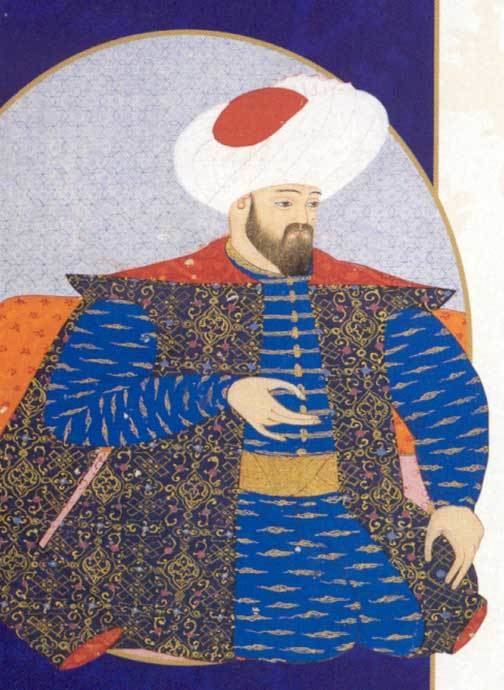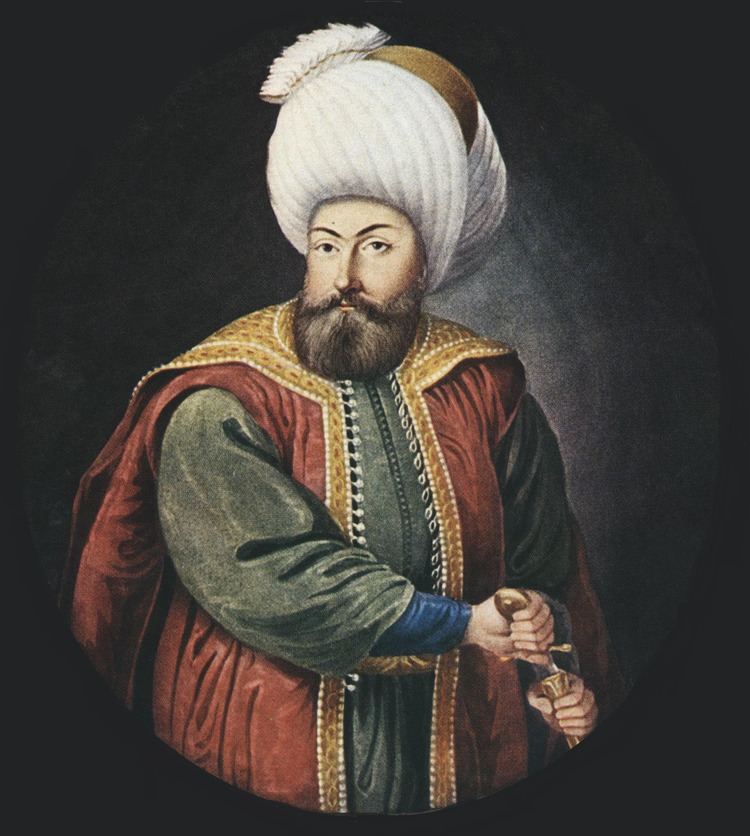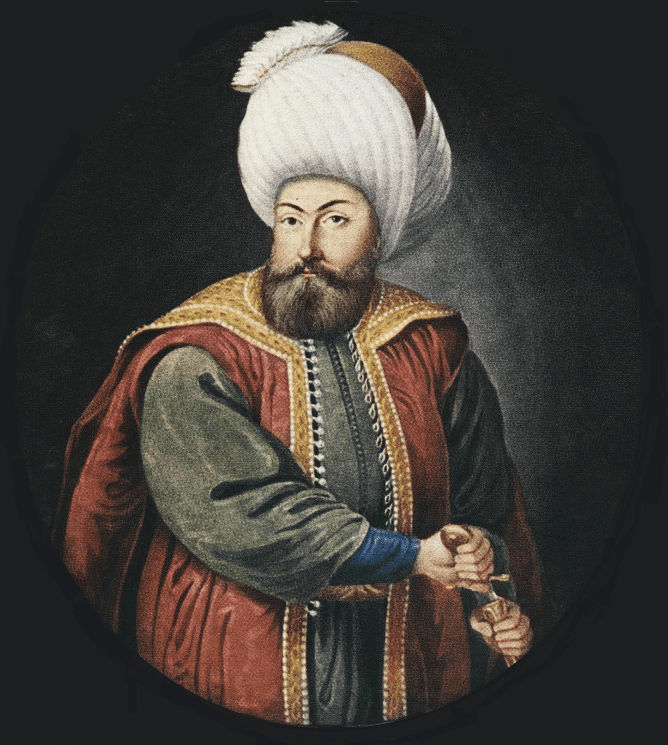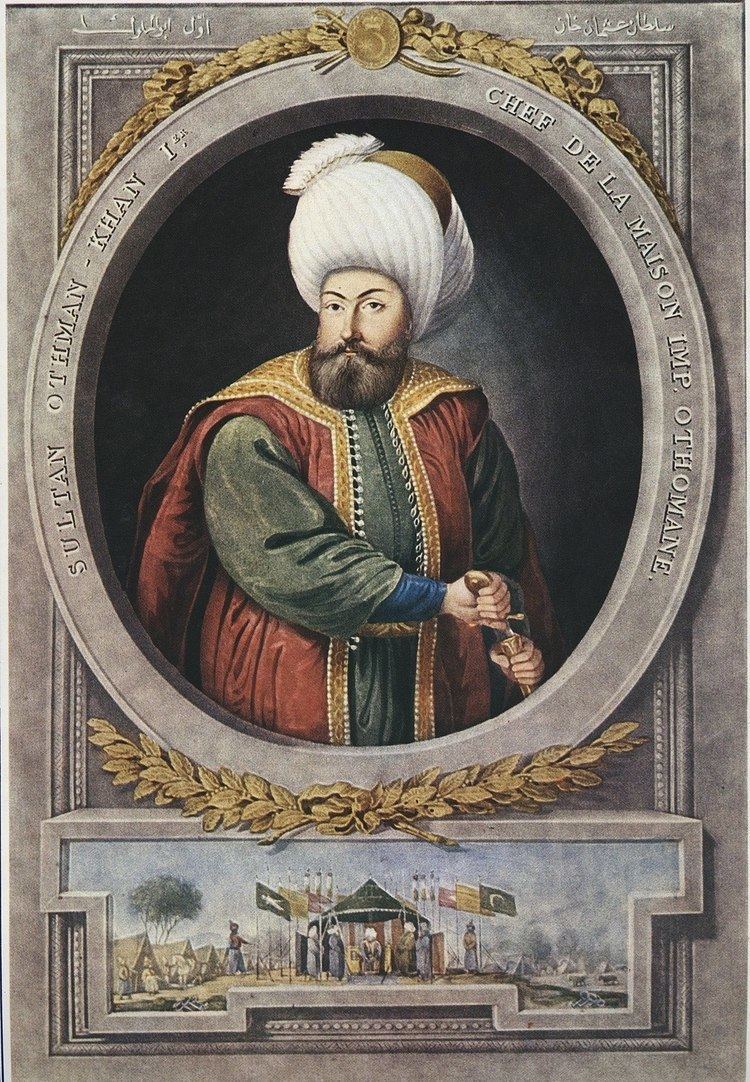Predecessor Position established Role Political leader Successor Orhan Buried Tomb of Osman I | Royal house House of Osman Parents Ertugrul, Halime Hatun Name Osman I | |
 | ||
Reign 17 January 1299 – 29 July 1326 Coronation 3 May 1281 and 4 September 1299 Consort Malhun HatunRabia Bala Hatun Died February 1326, Sogut, Turkey Similar Mehmed the Conqueror, Murad I, Sheikh Edebali | ||
Osman i the founding father of the ottoman empire
Osman I or Osman Gazi (Ottoman Turkish: عثمان غازى ʿOsmān Ġāzī; Turkish: I. Osman, Osman Gazi, Osman bey, Osman Han, Osman Alp; died 1323/4), sometimes transliterated archaically as Othman, was the leader of the Ottoman Turks and the founder of the Ottoman dynasty. He and the dynasty bearing his name later established and ruled the nascent Ottoman Empire (then known as the Ottoman Beylik or Emirate). The state, while only a small principality during Osman's lifetime, transformed into a world empire in the centuries after his death. It existed until shortly after the end of World War I. Historians commonly mark the end date at the abolition of the sultanate in 1922, or the proclamation of the Republic of Turkey in 1923, or the abolition of the caliphate in 1924.
Contents
- Osman i the founding father of the ottoman empire
- Osmans name
- Origin of the Ottoman Empire
- Osmans Dream
- Military victories
- Family
- Marriages
- Sons
- Daughter
- The Sword of Osman
- References

Due to the scarcity of historical sources dating from his lifetime, very little factual information is known about him. Not a single written source survives from Osman's reign. The Ottomans did not record the history of Osman's life until the fifteenth century, more than a hundred years after his death. Because of this, it is very challenging for historians to differentiate between fact and myth in the many stories told about him. One historian has even gone so far as to declare it impossible, describing the period of Osman's life as a "black hole."

According to later Ottoman tradition, Osman's ancestors were descendants of the Kayı tribe of Oghuz Turks. The Ottoman principality was just one of many Anatolian beyliks that emerged in the second half of the thirteenth century. Situated in the region of Bithynia, Osman's principality was particularly well-placed to launch attacks on the vulnerable Byzantine Empire, which his descendants would eventually go on to conquer.

Osman's name
Some scholars have argued that Osman's original name was Turkish, probably Atman or Ataman, and was only later changed to ʿOsmān, of Arabic origin. The earliest Byzantine sources, including Osman's contemporary George Pachymeres, spell his name as Ατουμάν (Atouman) or Ατμάν (Atman), whereas Greek sources regularly render both the Arabic form ʿUthmān and the Turkish version ʿOsmān with θ, τθ, or τσ. An early Arabic source mentioning him also writes ط rather than ث in one instance. Osman may thus have adopted the more prestigious Muslim name later in his life.
Origin of the Ottoman Empire
The exact date of Osman's birth is unknown, and very little is known about his early life and origins due to the scarcity of sources and the many myths and legends which came to be told about him by the Ottomans in later centuries. He was most likely born around the middle of the thirteenth century, possibly in 1254/5, the date given by the sixteenth-century Ottoman historian Kemalpaşazade. According to Ottoman tradition, Osman's father Ertuğrul led the Turkic Kayı tribe west from Central Asia into Anatolia, fleeing the Mongol onslaught. He then pledged allegiance to the Sultan of the Anatolian Seljuks, who granted him dominion over the town of Söğüt on the Byzantine frontier. This connection between Ertuğrul and the Seljuks, however, was largely invented by court chroniclers a century later, and the true origins of the Ottomans thus remain obscure.
Osman became chief, or Bey, upon his father’s death (c. 1280). Nothing is known for certain about Osman's early activities, except that he controlled the region around the town of Söğüt and from there launched raids against the neighboring Byzantine Empire. The first datable event in Osman's life is the Battle of Bapheus in 1301 or 1302, in which he defeated a Byzantine force sent to counter him.
Osman appears to have followed the strategy of increasing his territories at the expense of the Byzantines while avoiding conflict with his more powerful Turkish neighbors. His first advances were through the passes which lead from the barren areas of northern Phrygia near modern Eskişehir into the more fertile plains of Bithynia; according to Stanford Shaw, these conquests were achieved against the local Byzantine nobles, "some of whom were defeated in battle, others being absorbed peacefully by purchase contracts, marriage contracts, and the like."
These early victories and exploits are favorite subjects of Ottoman writers, especially in love stories of his wooing and winning the fair Mal Hatun. These legends have been romanticized by the poetical pens which recorded them in later years. The Ottoman writers attached great importance to this legendary, dreamlike conception of the founder of their empire.
Osman's Dream
Osman I had a close relationship with a local religious leader of dervishes named Sheikh Edebali, whose daughter he married. A story emerged among later Ottoman writers to explain the relationship between the two men, in which Osman had a dream while staying in the Sheikh's house. The story appears in the late fifteenth-century chronicle of Aşıkpaşazade as follows:
"He saw that a moon arose from the holy man's breast and came to sink in his own breast. A tree then sprouted from his navel and its shade compassed the world. Beneath this shade there were mountains, and streams flowed forth from the foot of each mountain. Some people drank from these running waters, others watered gardens, while yet others caused fountains to flow. When Osman awoke he told the story to the holy man, who said 'Osman, my son, congratulations, for God has given the imperial office to you and your descendants and my daughter Malhun shall be your wife."
The dream became an important foundational myth for the empire, imbuing the House of Osman with God-given authority over the earth and providing its fifteenth-century audience with an explanation for Ottoman success. The dream story may also have served as a form of compact: just as God promised to provide Osman and his descendants with sovereignty, it was also implicit that it was the duty of Osman to provide his subjects with prosperity.
Military victories
According to Shaw, Osman's first real conquests followed the collapse of Seljuk authority when he was able to occupy the fortresses of Eskişehir and Karacahisar. Then he captured the first significant city in his territories, Yenişehir, which became the Ottoman capital.
In 1302, after soundly defeating a Byzantine force near Nicaea, Osman began settling his forces closer to Byzantine controlled areas.
Alarmed by Osman's growing influence, the Byzantines gradually fled the Anatolian countryside. Byzantine leadership attempted to contain Ottoman expansion, but their efforts were poorly organized and ineffectual. Meanwhile, Osman spent the remainder of his reign expanding his control in two directions, north along the course of the Sakarya River and southwest towards the Sea of Marmora, achieving his objectives by 1308. That same year his followers participated in conquest of the Byzantine city of Ephesus near the Aegean Sea, thus capturing the last Byzantine city on the coast, although the city became part of the domain of the Emir of Aydin.
Osman's last campaign was against the city of Bursa. Although Osman did not physically participate in the battle, the victory at Bursa proved to be extremely vital for the Ottomans as the city served as a staging ground against the Byzantines in Constantinople, and as a newly adorned capital for Osman's son, Orhan.
Family
Due to the scarcity of sources about his life, very little is known about Osman's family relations. According to certain fifteenth-century Ottoman writers, Osman was descended from the Kayı branch of the Oghuz Turks, a claim which later became part of the official Ottoman genealogy and was eventually enshrined in the Turkish Nationalist historical tradition with the writings of M. F. Köprülü. However, the claim to Kayı lineage does not appear in the earliest extant Ottoman genealogies. Thus many scholars of the early Ottomans regard it as a later fabrication meant to shore up dynastic legitimacy with regard to the empire's Turkish rivals in Anatolia.
It is very difficult for historians to determine what is factual and what is legendary about the many stories the Ottomans told about Osman and his exploits, and the Ottoman sources do not always agree with each other. According to one story, Osman had an uncle named Dündar with whom he had a quarrel early in his career. Osman wished to attack the local Christian lord of Bilecik, while Dündar opposed it, arguing that they already had enough enemies. Interpreting this as a challenge to his leadership position, Osman shot and killed his uncle with an arrow. This story does not appear in many later Ottoman historical works. If it were true, it means that it was likely covered up in order to avoid tarnishing the reputation of the Ottoman Dynasty's founder with the murder of a family member. It may also indicate an important change in the relationship of the Ottomans with their neighbors, shifting from relatively peaceful accommodation to a more aggressive policy of conquest.
Marriages
Sons
Daughter
The Sword of Osman
The Sword of Osman (Turkish: Taklide-Seif) was an important sword of state used during the coronation ceremony of the Ottoman Sultans. The practice started when Osman was girt with the sword of Islam by his father-in-law Sheik Edebali. The girding of the sword of Osman was a vital ceremony which took place within two weeks of a sultan's accession to the throne. It was held at the tomb complex at Eyüp, on the Golden Horn waterway in the capital Constantinople. The fact that the emblem by which a sultan was enthroned consisted of a sword was highly symbolic: it showed that the office with which he was invested was first and foremost that of a warrior. The Sword of Osman was girded on to the new sultan by the Sharif of Konya, a Mevlevi dervish, who was summoned to Constantinople for that purpose.
